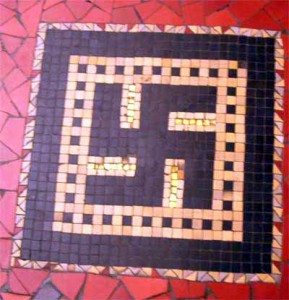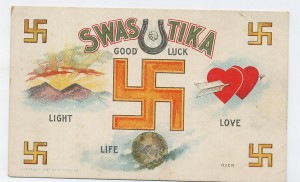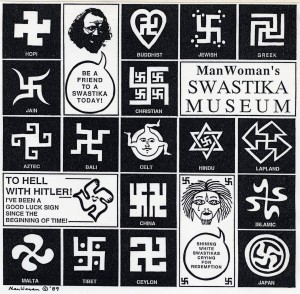about swastikas

The Swastika: in Europe, especially in Germany, most people know it as a right-wing symbol of the Nazis, Hitler’s emblem and banner of the “German Empire” below which crime and war were brought to our world. However the symbol had originally a complete different meaning.
The Swastikacrux is one of the oldest symbols. It has been used for thousands of years in nearly every culture as a positive sign of luck. .
In our society the swastika is the sign of the Third Reich and is associated with many crimes under this name. The Swastika isn’t an invention of the Nazis, they took this symbol and violated it for their own purposes.
Everybody has to know the real origin and relevance of the sign, especially because it was forbidden to teach about the real meaning of the Swastika.
This censorship still affects us today, although the sun gear was used long before the second world war in Germany as a symbol of luck, it seems an impartial acquaintance in Germany with the Swastika is impossible.
The story about the Nazis taking the Swastika and reversing it to make it into a negative symbol is untrue. Both left and right-facing Swastikas are used in cultures worldwide.

The origins
The expression Swastika comes from the Sanskrit (a language from the Indian
subcontinent) word “Svastika”, composed of the syllables SU – (good) and ASTI (to be), meaning “to be lucky” or “salutary” or “what is good”.
In Latin the symbol was called CRUX GAMMATA or GAMMADION, because its angles look like four backwards grecian gammas .
In Germany the symbol is called “sun gear”, “goniometercrux” and since the 19th century most often “fylfot”.

Historians disagree on where the birthplace of the Swastika is located.
Commonly the origin is thought to be in Mesopotamia, and from this country it spread to many other cultures.
One of the oldest known Swastika is found in a 10,000 year old Stone-Age cave. Because the Swastika is a simple, almost universal sign, it was used in many various cultures with no obvious connection to one another. There are numerous examples, the women of some indigenous tribes in Brazil wear shields with Swastikas over their genitals to symbolize mother-love.
For the Mayans the Swastika stood for creation and for the Incas and Aztecs it represented the four seasons due to its four arms, the centre symbolizing the sun. The Swastika is found in many Mesoamerican works of art, which shows it must have circulated.
The Swastika is used in Islamic art and is also seen in Christian and Byzantine Empire art. The Greeks associated the Swastika with the sun god Apollo, and it was painted on clothes, houses, ceramics and many other items. It was a holy symbol, and priests burned them and wore them on their clothing.
In the Roman empire the Swastika stood for the god Jupiter and frequently appeared in mosaics.
Tattooed Africans see the Swastika as a representation of fertility and Japanese Samurai wore them on their armour. Also the Celts, Vikings, Jews, Buddhists, Hindus and the ancient Egyptians used the Swastika, examples of which can be seen in museums, collections and records from all over the world.
It is noticeable that the Swastika is always used as a positive symbol, irrespective of which culture it is used by. It is a sign meaning birth, luck, fertility, and creation. It embodies life and the changing of the seasons.
The Swastika in the “West”
The Swastika can often be seen in Europe.
For example, the Celts in Ireland and Scotland frequently used to carve it on their tombstones, and the Scandanavians used it as a symbol of “Thor’s hammer”.
In the 20th century the Swastika celebrated its rediscovery and is beginning to be used again. You can find it as a symbol of luck for the Finnish airforce on their planes and the famous Carslberg beer from Copenhagen in Denmark had the Swastika on their bottles from 1881 until the second world war.
In Ontario, Canada, is a city named Swastika. During the second world war the goverment renamed the city Winston, but the people of the city wanted to keep the name and protested using the slogan “To hell with Hitler, we came up with our name first”. To this day, the city is still called Swastika.

Before the Nazi regime there were many cities named Swastika, but they mostly changed their names due to the war. There were several hockey teams with this name, and the Swastika could also be found on poker chips, and clothing, Coca-Cola distributed Swastikas as part of a sales campaign and it could be found on many postcards. American Pathfinder awarded a “white Swastika” emblem to people who had done something good. The Laguna bridg in Colorado is decorated with big Swastikas and one of the bigest women’s societies wore it as their name and emblem before somebody renamed them 1942. In the “wild West” the Swastika was used as a brand on livestock, the idea behind this being that the Swastika is built from four “L” which stand for “Luck, Life, Love and Liberty”.
In Great Britain too, the Swastika could be found on several everyday items and as a mosaic pattern and in architecture, and even in Germany, long before the Nazis, the Swastika was a symbol of good luck akin to the horseshoe or four-leaf clover, but of course all this changed due to the second world war.
![hockeycanswat[1]](https://www.little-swastika.com/wp-content/uploads/2011/01/hockeycanswat1.jpg)
The Swastika in the “East”
The basic difference in common use of the Swastika between Western and Eastern culture is that in the West the negative associations due to the abuse of the symbol by the nazis caused the Swastika to almost completely disappear, but in the East it has continued to be used as an auspicious symbol.
The swastika is very important in Buddhism and is known as “Buddha’s heart”.
Some Buddhists say that in every picture of Buddha a Swastika should be seen on his chest. In Asia you can find Swastikas on huge statues of the Buddha, on buildings, clothes, packaging, jewellery, ornaments, and many more kinds of item. Hindus and Jains see the Swastika as a symbol of luck and of the highest Creator. In fact, in Hinduism it is almost on a par with how widespread and important the symbol of the Cross is for Christians. The elephant god Sri Ganesha has a swastika in his palm. Ganesha is popularly worshipped as a remover of obstacles, though traditionally he also places obstacles in the path of those who need to be checked.

In the Chinese alphabet, the Swastika in a circle stands for “sun”, and without the circle it means the number 10,000 (in Chinese: wan or Wantzü) which means “come from the heavens”. If you find the Swastika on Chinese food packaging it is a sign that it is a pure vegetarian product, and followers of the Falun Gong religion wear five Swastikas. In Tibet it is not unusual for the monks to get swastika tattoos as an outward show of their spirituality. The throne of the Dalai Lama is decorated with four Swastikas and you find throughout Tibet and Nepal on everyday items and as a marking denoting monasteries.
The future
Along as the Swastika is associated with the Third Reich, there will be a negative attitude to it in our culture. The Swastika is the most easily recognisable and “powerful” symbol of Nazism therefore its use is frowned upon and discouraged. It is very difficult in modern Western culture, particularly in Germany, to use the Swastika in its original context as a positive symbol.
![Lightmatter_buddha_with_swastika[1]](https://www.little-swastika.com/wp-content/uploads/2011/01/Lightmatter_buddha_with_swastika1.jpg)
In no way do the writers of this article approve the actions of the Nazis.
We do not want to promote the abuse of this symbol by those who preach hatred and intolerance. It is hugely important to us that the non-Nazi use of the Swastika is clearly defined, and that we use the Swastika in a peaceful and positive way now and in the future.
This article is intended as something educational and thought-provoking. It is deeply sad that a dictatorial regime appropriated a symbol and used it so visibly and attached to such reprehensible acts that it now has a negative meaning for most people. We want to show that the Swastika has a history going back for millennia and that there are cultures who still see it as holy and meaningful.

You should not take every Swastika you see to be a Nazi symbol. If everyone reads this and passes it on then it is taking steps towards reinstatement of this symbol in our culture as something positive, peaceful and beautiful.
fight against racism – the hate of stupid idiots
but not against a sign – because its innocent

little-swastika
[nggallery id=18]



